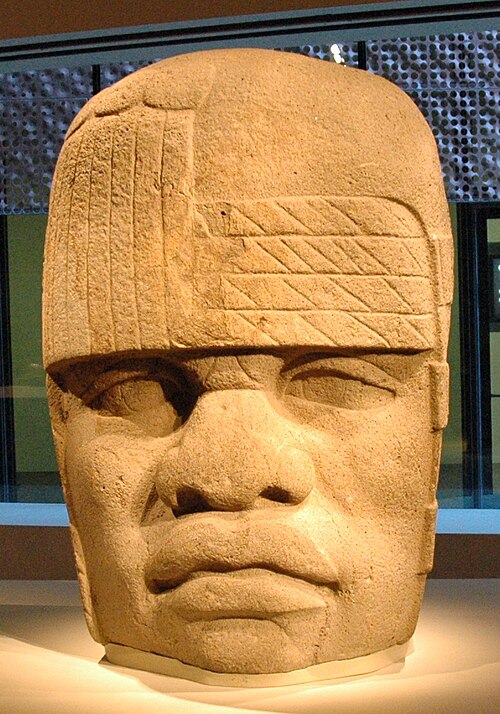
What are the Olmec colossal heads? The Olmec colossal heads are a group of 17 giant heads carved out of stone by the Olmec people in sometime before 900 BC.
The Olmec people were an early civilization living in what is now the Mexican states of Veracruz and Tabasco, in the south of Mexico, near Guatemala. They appeared in about 1400 BC and were probably a group that split off from nearby tribes. They developed their own culture and intensively farmed. The area was very fertile, and farming was easy. More food meant more people, and the population grew. An elite class of rulers developed, and they started to make symbolic and decorative luxury items out of rare rocks, such as jade and obsidian. They were one of the first civilizations in South America to live in towns and cities, and they were the first peoples to construct large monuments. The Olmec civilization peaked in roughly 900 BC and then mysteriously disappeared around 400 BC. To this day, no one knows why they disappeared. There are theories about volcanoes, earthquakes, a loss of fertile lands, and an inability to farm, but no one knows the real reason. It is probably a combination of all of these things.
The Olmec colossal heads were made by the Olmec people at the peak of their civilization. There were 17 heads in all, and they were lost to the wilderness until they were rediscovered in 1850. The heads are different sizes. The smallest is 1.47 meters tall and the biggest is 3.4 meters tall. They weigh between 6 and 45 tons. Each head has a different face and a different headdress, implying that they are meant to be different people. They are gathered in four separate locations: San Lorenzo Tenochtitlan, La Venta, Tres Zapotes, and La Cobata. The majority of them are in San Lorenzo, which was the Olmec’s major city, technically their capital city. La Venta and Trez Zapotes were two other very important cities. No one knows exactly when the heads were made because they have all been removed from the original sites by archaeological excavations. It is thought that they were buried by 900 BC, so they must have been made before then.
All of the colossal heads have been carved out of basalt, which is an igneous rock that forms when lava cools. It is a fairly dense and hard rock, scoring a 6 on the Mohs scale of hardness. Sandstone scores a 1 on that, and diamond scores a 10. Granite gets a 7. The basalt for the sculptures came from the Sierra de los Tuxtlas mountains, 150 km away from where they were finally displayed. The location is known because the quarry and the workshops have been found. It is not known how they transported the heads from where they were mined to where they were displayed, but there is a theory. People in South America did not have horses or oxen, and they did not have the wheel, so they were limited in the methods they could use. However, they did have boats, and they did live in an area that regularly flooded. This was a blessing and a curse when it came to moving giant sculptures. They would have been able to make causeways and use boats to ferry the heads across some areas, but this wouldn’t have worked in swamps and the hilly areas. They probably got over those by using wooden sledges and pure manpower. The heads all have flat backs, which would have made it easier to get them onto a sledge and a boat. They were carved once they were in position. They didn’t have any metal tools, so they carved the heads using stone tools, such as hammers, and then they carved the more delicate features using reeds and wet sand as a kind of sandpaper. The heads were originally painted in bright colors, but those paints have all worn off.
As it would have taken a lot of manpower and resources to make these, they must have either been religious projects or vanity projects. Most experts think that they were made to represent individual leaders and were probably either commissioned by those leaders or by successive leaders after they had died. The heads all look like individual people and were most likely modeled on a real person. If they were religious in purpose, they would be more similar in style and probably less human-looking, such as the Moai on Easter Island. There is also a theory that they were buried pretty soon after they were made, either as part of an ancestor worship ceremony or by their successors trying to strengthen their power. As all of the statues have been moved from where they were placed, it is impossible to know. And this is what I learned today.
Buy volumes 1 to 3 on Kindle: https://mybook.to/volumesonetothree
Sources
https://www.worldhistory.org/article/672/olmec-colossal-stone-heads
https://www.thoughtco.com/the-colossal-heads-of-the-olmec-2136318
https://en.wikipedia.org/wiki/Olmec_colossal_heads
https://en.wikipedia.org/wiki/San_Lorenzo_Tenochtitl%C3%A1n
https://www.discovermagazine.com/the-3-400-year-old-olmec-colossal-heads-origins-44082
https://en.wikipedia.org/wiki/Olmecs
Image By Marshall Astor (Life on the Edge), CC BY-SA 2.0, https://commons.wikimedia.org/w/index.php?curid=19349056
